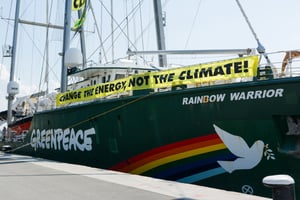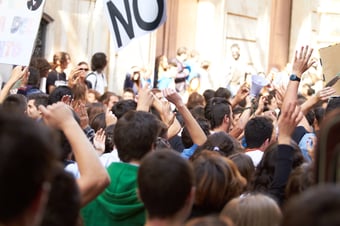At the Coal Face: Direct Action as Environmental Protest
While the bulk of the media attention in 2019 was on Extinction Rebellion (XR), which has become a global movement since its establishment in the UK in October 2018, it is only the latest in a long list of radical environmental groups that have been around for much longer. Greenpeace, arguably the most well-known environmental activist organisation, continued to make headlines in 2019, especially for its targeting of oil and gas companies' maritime operations. Another movement that has been steadily gaining traction in Europe is Ende Gelände, which focuses on opposing the coal and nuclear power industry in Germany. Below we profile these three movements, assessing what they intend to do, and how, and what to expect from them in 2020.
EXTINCTION REBELLION
XR is a decentralised movement that uses non-violent civil disobedience tactics to pressure governments to act on climate change. The movement has experienced extraordinary global growth, currently boasting more than 480 branches in 54 countries. By October 2019, it had raised more than USD 3.3 million in the previous 12 months. Its supporters typically block and occupy prominent roads and places (for example, government buildings, train stations and airports), sometimes by chaining or gluing themselves to structures. These incidents have caused significant transportation and commercial disruptions. Most protests have occurred in the UK – costing the police more than USD 50 million in 2019 – although its activities are spreading across Western Europe, Australasia and North America. In addition to demonstrations in public places, the movement has been targeting the commercial sector. For example, in April, activists vandalised an oil major’s London headquarters. In October and November, XR supporters protested outside the London offices of a major global asset manager, clashed with police outside a mining conference in Melbourne, Australia, and blocked passenger access to a private jet terminal in Geneva Airport, Switzerland.
| What to expect in 2020: XR’s decentralised structure adds a degree of unpredictability to the activities of its members and supporters. That said, XR activists are likely to intensify disruptive protests in 2020, although they will be careful to not overly inconvenience the public. For instance, the London tube disruption in October was extremely polarising – many commuters felt that disrupting their passage to work was not an effective way to instigate change. The group is highly likely to increase protests against companies that it claims are contributing to the climate crisis. This may include the spread of protests to mining or oil and gas sites. |
GREENPEACE
 Greenpeace, founded in 1971, remains the world’s largest environmental activist group, with a long history of targeting government and commercial assets to protest climate change. It has an established presence in more than 55 countries, with over 3,000 staff and 15,000 volunteers. Its tactics vary from public protests to more direct non-violent actions, such as storming into nuclear or coal-fired power stations and occupying oil rigs and vessels. What distinguishes Greenpeace from most other environmental groups is its maritime capabilities, comprising four ocean-going vessels and many inflatable boats. This allows the organisation to conduct protest actions offshore, sometimes in remote places, which continued to make headlines in 2019. For example, in June, Greenpeace activists targeted an oil rig in the North Sea, occupying it and forcing it to make a U-turn on three occasions, successfully preventing it from reaching new drilling sites. This incurred significant costs and operational delays for the rig’s operator. In another incident in September, Greenpeace activists boarded two oil platforms to protest the operator’s plan to leave parts of old drilling structures with 11,000 tonnes of oil in the North Sea.
Greenpeace, founded in 1971, remains the world’s largest environmental activist group, with a long history of targeting government and commercial assets to protest climate change. It has an established presence in more than 55 countries, with over 3,000 staff and 15,000 volunteers. Its tactics vary from public protests to more direct non-violent actions, such as storming into nuclear or coal-fired power stations and occupying oil rigs and vessels. What distinguishes Greenpeace from most other environmental groups is its maritime capabilities, comprising four ocean-going vessels and many inflatable boats. This allows the organisation to conduct protest actions offshore, sometimes in remote places, which continued to make headlines in 2019. For example, in June, Greenpeace activists targeted an oil rig in the North Sea, occupying it and forcing it to make a U-turn on three occasions, successfully preventing it from reaching new drilling sites. This incurred significant costs and operational delays for the rig’s operator. In another incident in September, Greenpeace activists boarded two oil platforms to protest the operator’s plan to leave parts of old drilling structures with 11,000 tonnes of oil in the North Sea.
| What to expect in 2020: Greenpeace’s tactics are unlikely to change drastically. However, the organisation will continue to target the fossil fuel industry offshore, and potentially intensify such operations, despite the threat of arrests and legal prohibitions. In 2020, Greenpeace wants to pressure governments to agree on a global ocean treaty to safeguard the world’s oceans, and to commit to protecting at least 30 percent of the oceans by 2030. |
ENDE GELÄNDE
Ende Gelände, unlike Greenpeace and XR, is not a global movement. It is a Germany-based alliance of anti-coal and anti-nuclear organisations that was established in 2015, although it has been steadily establishing a presence in other European countries. Its large-scale and non-violent but disruptive protest actions – which mainly involves occupying coal mines and preventing the delivery of coal to power plants – have generated considerable media attention in Europe. In June 2019, for instance, hundreds of Ende Gelände protesters broke into the Garzweiler surface mine in Germany’s North Rhine-Westphalia State, which produces raw materials used in coal-fired power stations, and suspended operations. The incident happened a day after Ende Gelände activists blockaded railway tracks to prevent the supply of coal to one of Germany's main coal-fired plants in North Rhine-Westphalia. More recently, in November, thousands of protesters broke through police lines and blocked train tracks at two mines in Brandenburg, and another in Saxony. Local reports indicate Ende Gelände’s actions have caused substantial logistical and operational delays.
| What to expect in 2020: Encouraged by a steady rise in popularity in recent years, and mounting environmental activism around the world, Ende Gelände will likely seek to stage more protest actions this year, despite the increased threat of lawsuits and arrests in Germany. The movement is not likely to gain enormous global following, but its presence and level of support will continue to increase across Europe. |
 MANAGING YOUR PROFILE, UNDERSTANDING THE THREAT
MANAGING YOUR PROFILE, UNDERSTANDING THE THREAT
With targeted protest action by environmental and climate-change activists likely to continue into 2020, commercial operators around the world have already started to consider the implications for their people, business, assets and, importantly, reputations. Lenoy Barkai, Associate Director in S-RM's security risk team, talks us through some key considerations for organisations facing direct protest action.
Three practical first steps include:
- Understand your company profile as it relates to the intent of activist groups
Activist groups will look to maximise the impact of their protest action by selecting targets whose profiles most closely match their agendas. Consider whether your industry, brand, communication channels and/or response to the claims of environmental activists are likely to increase or reduce their intent to single you out as a prospective target. Are there proportionate and practical steps you can take to reduce your profile which align with your business objectives and corporate values - Understand the capability levels and tactics of activist groups
Some industries, such as the extractive sector for example, are more prone to environmental activism than others and should therefore understand the extent and nature of these groups’ capabilities to meaningfully impact their operations. Key factors to consider here include the groups’ mobilisation power, proclivity for peaceful, disruptive or violent protest action, the typical duration of a protest, and common tactics used. The impact of a road-blockade preventing your staff and service providers from accessing your site will be very different to the implications of direct threats made against your management team, for example. - Consider your response carefully
Finally, your response to targeted activism in terms of both communication and security will have a ripple effect. Done correctly, with careful community engagement and stakeholder mapping, a sound response can effectively placate a tense situation, pivoting from criticism to constructive dialogue. A knee-jerk or disproportionate response, on the other hand, may cause backlash and exacerbate the issue. Businesses will enhance their ability to fulfil their duty of care to staff and operational responsibilities by understanding the nuanced nature of responding to targeted environmental activism.
Read our 2020 Political Violence Special Edition for more global security insights.
